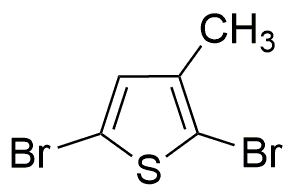2,5-Dibromo-3-methylthiophene is widely utilized in research focused on:
- Organic Electronics: This compound is used in the development of organic semiconductors, which are essential for creating flexible electronic devices like OLEDs (Organic Light Emitting Diodes) and organic solar cells.
- Pharmaceuticals: It serves as an intermediate in the synthesis of various pharmaceutical compounds, aiding in the creation of new drugs with improved efficacy and reduced side effects.
- Material Science: The compound is valuable in the production of specialty polymers and coatings, enhancing material properties such as conductivity and thermal stability.
- Agricultural Chemicals: It can be utilized in the formulation of agrochemicals, contributing to the development of pesticides and herbicides that are more effective and environmentally friendly.
- Research and Development: As a building block in synthetic chemistry, it supports academic and industrial research aimed at discovering new chemical reactions and materials.
Informations générales
Propriétés
Sécurité et réglementation
Applications
2,5-Dibromo-3-methylthiophene is widely utilized in research focused on:
- Organic Electronics: This compound is used in the development of organic semiconductors, which are essential for creating flexible electronic devices like OLEDs (Organic Light Emitting Diodes) and organic solar cells.
- Pharmaceuticals: It serves as an intermediate in the synthesis of various pharmaceutical compounds, aiding in the creation of new drugs with improved efficacy and reduced side effects.
- Material Science: The compound is valuable in the production of specialty polymers and coatings, enhancing material properties such as conductivity and thermal stability.
- Agricultural Chemicals: It can be utilized in the formulation of agrochemicals, contributing to the development of pesticides and herbicides that are more effective and environmentally friendly.
- Research and Development: As a building block in synthetic chemistry, it supports academic and industrial research aimed at discovering new chemical reactions and materials.
Documents
Fiches de données de sécurité (FDS)
La FDS fournit des informations de sécurité complètes sur la manipulation, le stockage et l’élimination du produit.
Spécifications du produit (PS)
Le PS fournit une description complète des propriétés du produit, notamment sa composition chimique, son état physique, sa pureté et les exigences de stockage. Il détaille également les plages de qualité acceptables et les applications prévues du produit.
Certificats d'analyse (COA)
Recherchez des certificats d'analyse (COA) en saisissant le numéro de lot du produit. Les numéros de lot et de lot se trouvent sur l'étiquette d'un produit, après les mots « Lot » ou « Lot de fabrication ».
Numéro de catalogue
Numéro de lot/série
Certificats d'origine (COO)
Ce certificat d'exploitation confirme le pays dans lequel le produit a été fabriqué, et détaille également les matériaux et composants utilisés et s'il est issu de sources naturelles, synthétiques ou autres sources spécifiques. Ce certificat peut être requis pour les douanes, le commerce et la conformité réglementaire.
Numéro de catalogue
Numéro de lot/série
Fiches de données de sécurité (FDS)
La FDS fournit des informations de sécurité complètes sur la manipulation, le stockage et l’élimination du produit.
DownloadSpécifications du produit (PS)
Le PS fournit une description complète des propriétés du produit, notamment sa composition chimique, son état physique, sa pureté et les exigences de stockage. Il détaille également les plages de qualité acceptables et les applications prévues du produit.
DownloadCertificats d'analyse (COA)
Recherchez des certificats d'analyse (COA) en saisissant le numéro de lot du produit. Les numéros de lot et de lot se trouvent sur l'étiquette d'un produit, après les mots « Lot » ou « Lot de fabrication ».
Numéro de catalogue
Numéro de lot/série
Certificats d'origine (COO)
Ce certificat d'exploitation confirme le pays dans lequel le produit a été fabriqué, et détaille également les matériaux et composants utilisés et s'il est issu de sources naturelles, synthétiques ou autres sources spécifiques. Ce certificat peut être requis pour les douanes, le commerce et la conformité réglementaire.


